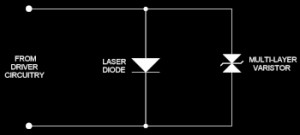ESD polarity terminology used on this web site
The term “positive-ESD” is used to mean electrostatic discharge (ESD) whose voltage polarity would tend to forward-bias a laser diode. “Negative-ESD,” means ESD whose voltage polarity would tend to reverse-bias a laser diode.
|
Review of ESD approaches |
||||
| START | PREV | CURRENT | NEXT/END |
|
|
Introduction << |
||||
Review of ESD approaches
Multi-layer varistor used as an ESD protection means
 Multi-layer varistor used for ESD protectionThe figure to the right shows another approach commonly employed to protect a laser diode from ESD. In this approach a multi-layer varistor is placed in parallel with the laser diode. A multi-layer varistor is a device whose resistance changes, decreasing nonlinearly, with increases in voltage that appear across the terminals.
Multi-layer varistor used for ESD protectionThe figure to the right shows another approach commonly employed to protect a laser diode from ESD. In this approach a multi-layer varistor is placed in parallel with the laser diode. A multi-layer varistor is a device whose resistance changes, decreasing nonlinearly, with increases in voltage that appear across the terminals.
Although some multi-layer varistors claim to have response times in the sub-nanosecond range, their breakdown voltage (the voltage at which the varistor transitions from high resistance to low resistance) is typically well in excess of the 2.2-volt lasing threshold, or 2.0-volt maximum reverse-bias voltage of a typical low-power laser diode. A multi-layer varistor whose breakdown voltage is below 3.6 volts is not known to us at Lasorb.
Therefore, this approach is not believed to be completely effective in preventing a low-power, fast-response laser diode from being damaged by 15,000-volt ESD.

